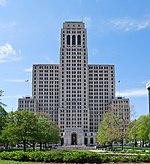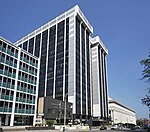Walter Merchant House

The Walter Merchant House, on Washington Avenue (New York State Route 5) in Albany, New York, United States, is a brick-and-stone townhouse in the Italianate architectural style, with some Renaissance Revival elements. Built in the mid-19th century, it was listed on the National Register of Historic Places in 2002.At the time of its construction it was surrounded by many similar houses, but it is now one of the rare remaining examples in the city of a townhouse with a surviving rear carriage house. It is one of the only remaining originally residential buildings on that section of Washington, currently used as the main offices of the New York chapter of the National Association of Social Workers.
Excerpt from the Wikipedia article Walter Merchant House (License: CC BY-SA 3.0, Authors, Images).Walter Merchant House
Washington Avenue, City of Albany
Geographical coordinates (GPS) Address External links Nearby Places Show on map
Geographical coordinates (GPS)
| Latitude | Longitude |
|---|---|
| N 42.656111111111 ° | E -73.762777777778 ° |
Address
Walter Merchant House
Washington Avenue 188
12210 City of Albany
New York, United States
Open on Google Maps











